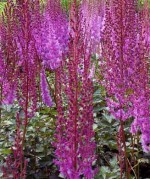 Fall astilbe is a clump forming herbaceous perennial native to China and a member of the saxifrage family, Saxifragaceae, that also includes Bergenia, foamflower (Tiarella), and coral bells (Heuchera). Hairy stems carry 2-3 ternately compound leaves with double toothed hairy leaflets . Narrow plume-like panicles of small tightly packed lilac flowers appear late in the season, two to four weeks after those of the popular Astilbe x arendsii. The seed heads that follow are attractive and persist into the winter. Fall astilbe is more tolerant of heat and drought that mamy astilbes and grow well in full sun in cool climates as long as the soil does not dry out. An excellent choice for shade and woodland gardens. The flowers are good cut flowers lasting over a week in the vase, and the seed heads are attractive in dried arrangements. The genus name Astilbe comes from the Greek words a meaning without and stilbe meaning brightness referring to the dull leaves of some species.
Fall astilbe is a clump forming herbaceous perennial native to China and a member of the saxifrage family, Saxifragaceae, that also includes Bergenia, foamflower (Tiarella), and coral bells (Heuchera). Hairy stems carry 2-3 ternately compound leaves with double toothed hairy leaflets . Narrow plume-like panicles of small tightly packed lilac flowers appear late in the season, two to four weeks after those of the popular Astilbe x arendsii. The seed heads that follow are attractive and persist into the winter. Fall astilbe is more tolerant of heat and drought that mamy astilbes and grow well in full sun in cool climates as long as the soil does not dry out. An excellent choice for shade and woodland gardens. The flowers are good cut flowers lasting over a week in the vase, and the seed heads are attractive in dried arrangements. The genus name Astilbe comes from the Greek words a meaning without and stilbe meaning brightness referring to the dull leaves of some species.
Type: Herbaceous perennial
Bloom: Narrow plume-like panicles of small tightly packed lilac flowers late in the season
Size: 2-4’ H x 2’ W
Light: Part shade to shade; sun in cool moist areas
Soil: Humus rich, moist, well-drained
Hardiness: Zones 4-8
Care: Remove foliage if it becomes brown or scorched.
Pests and Diseases: None of significance
Propagation: Division in spring or fall; species from seed
Companion Plants: Ferns, hosta, lythrum, hydrangea, day lily, Japanese anemone
Outstanding Selections:
‘Superba’ (lavender pink flowers)
‘Purple Lance’ (red-violet flowers)